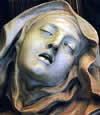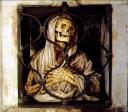The Catholic Church has refused to grant the Da Vinci Code sequel permission to shoot scenes in two Roman churches.
A spokesperson for the Catholic Church said they had immediately declined the requests to film in Santa Maria del Popolo and Santa Maria della Vittoria churches because the movies challenge Catholic beliefs.
Church official Monsignor Marco Fibbi said: “It’s a film that treats religious issues in a way that contrasts with common religious sentiment. We would be helping them create a work that might well be beautiful but that does not conform to our views.”
Hey, the Church is throwing them a bone already by suggesting that the stupid sequel to a stupid movie of a stupid book might turn out to be a thing of beauty.
 I can think of only one draw Santa Maria della Vittoria holds for this production: Bernini’s The Ecstasy of St. Teresa. It’s a famously sensual representation of St. Teresa’s vision of being pierced by an angel’s lance.
I can think of only one draw Santa Maria della Vittoria holds for this production: Bernini’s The Ecstasy of St. Teresa. It’s a famously sensual representation of St. Teresa’s vision of being pierced by an angel’s lance.  Then there are the guys in the opera boxes on both sides of the chapel watching her.
Then there are the guys in the opera boxes on both sides of the chapel watching her.
Doubtless the folks who brought you the theory that Mary Magdalene and Jesus were married and the Church supressed it to keep women down would find Teresa’s ecstasy all sorts of relevant.
 Santa Maria del Popolo is one of my favorite churches. I used to hang out in it often waiting for my friends who were always, always late meeting up at Piazza del Popolo. It has 2 Caravaggi (The conversion on the way to Damascus and the Crucifixion of Saint Peter), Pinturicchio frescoes, and a really cool tomb with a shrouded skeleton welcoming you when you first walk in.
Santa Maria del Popolo is one of my favorite churches. I used to hang out in it often waiting for my friends who were always, always late meeting up at Piazza del Popolo. It has 2 Caravaggi (The conversion on the way to Damascus and the Crucifixion of Saint Peter), Pinturicchio frescoes, and a really cool tomb with a shrouded skeleton welcoming you when you first walk in.
